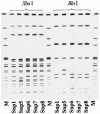Association between handling of pet treats and infection with Salmonella enterica serotype newport expressing the AmpC beta-lactamase, CMY-2
- PMID: 14532185
- PMCID: PMC254306
- DOI: 10.1128/JCM.41.10.4578-4582.2003
Association between handling of pet treats and infection with Salmonella enterica serotype newport expressing the AmpC beta-lactamase, CMY-2
Abstract
Resistance to the extended-spectrum cephalosporins can occur in Salmonella species via the production of extended-spectrum and AmpC beta-lactamases. We describe human infections with Salmonella enterica serotype Newport phage type 14 strains resistant to ceftazidime (CAZ) and cefoxitin (FOX) related to the handling of pet treats containing dried beef. These strains were isolated from five patients in Calgary, Alberta, Canada, during 2002 and were compared to a strain cultured from a commercial pet treat present at the property of one of the patients. The strains were resistant to FOX, CAZ, cefpodoxime, ampicillin, and chloramphenicol; intermediate resistant to ceftriaxone and cefotaxime; and sensitive to the aminoglycosides, ciprofloxacin, cefepime, and imipenem. Isoelectric focusing, multiplex PCR, and sequencing of the amplicons showed that all strains produced the plasmid-encoded AmpC beta-lactamase, CMY-2. Restriction analysis of plasmid DNA following transformation demonstrated that bla(CMY-2) was encoded on an approximately 140-kb plasmid. Pulsed-field gel electrophoresis showed the human and pet treat Salmonella strains to be highly related. This study is the first to implicate the transfer of multidrug-resistant Salmonella species through the handling of commercial pet treats containing animal products. In addition to documenting the first cases of human infection caused by CMY-2-producing S. enterica serotype Newport strains in Canada, this study illustrates the necessity of rapid and accurate laboratory-based surveillance in the identification of novel types of antimicrobial resistance.
Figures

References
-
- Ahmed, R., C. Bopp, A. Borczyk, and S. Kasatiya. 1987. Phage-typing scheme for Escherichia coli O157:H7. J. Infect. Dis. 155:806-809. - PubMed
Publication types
MeSH terms
Substances
LinkOut - more resources
Full Text Sources
Medical

